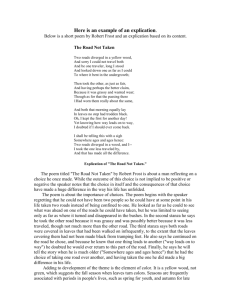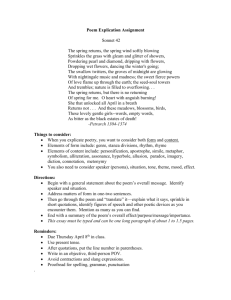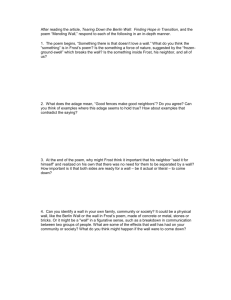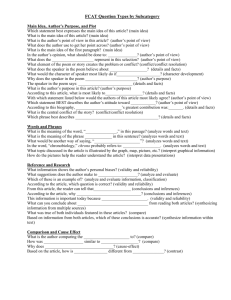Poetry Explication Guidelines
advertisement
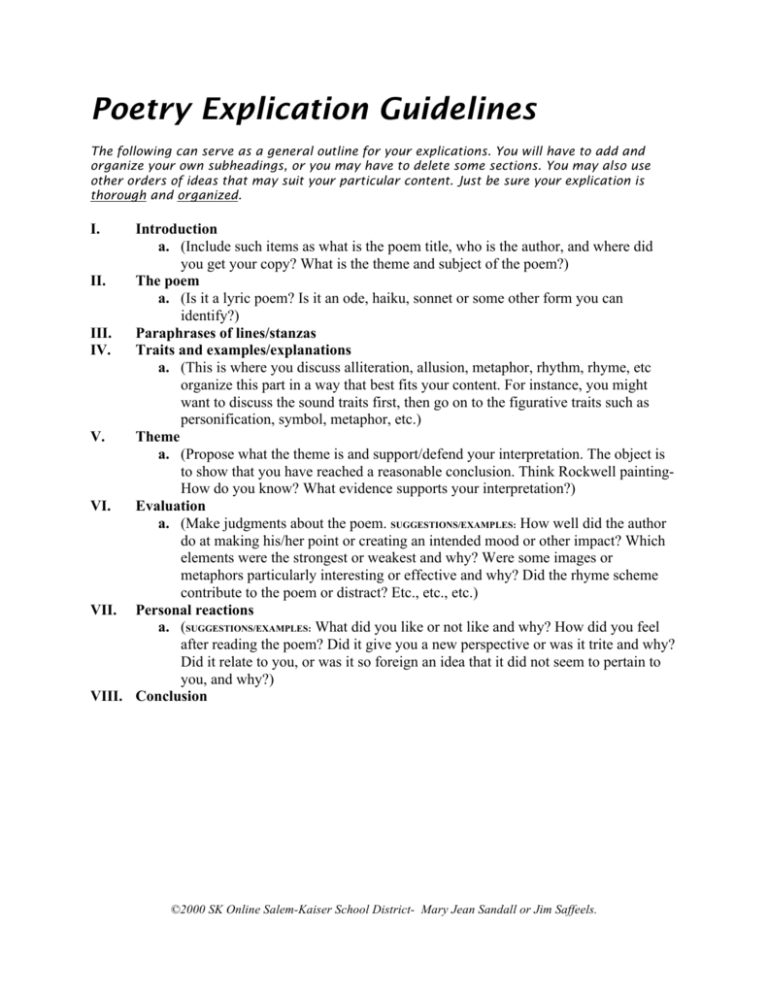
Poetry Explication Guidelines The following can serve as a general outline for your explications. You will have to add and organize your own subheadings, or you may have to delete some sections. You may also use other orders of ideas that may suit your particular content. Just be sure your explication is thorough and organized. I. Introduction a. (Include such items as what is the poem title, who is the author, and where did you get your copy? What is the theme and subject of the poem?) II. The poem a. (Is it a lyric poem? Is it an ode, haiku, sonnet or some other form you can identify?) III. Paraphrases of lines/stanzas IV. Traits and examples/explanations a. (This is where you discuss alliteration, allusion, metaphor, rhythm, rhyme, etc organize this part in a way that best fits your content. For instance, you might want to discuss the sound traits first, then go on to the figurative traits such as personification, symbol, metaphor, etc.) V. Theme a. (Propose what the theme is and support/defend your interpretation. The object is to show that you have reached a reasonable conclusion. Think Rockwell paintingHow do you know? What evidence supports your interpretation?) VI. Evaluation a. (Make judgments about the poem. SUGGESTIONS/EXAMPLES: How well did the author do at making his/her point or creating an intended mood or other impact? Which elements were the strongest or weakest and why? Were some images or metaphors particularly interesting or effective and why? Did the rhyme scheme contribute to the poem or distract? Etc., etc., etc.) VII. Personal reactions a. (SUGGESTIONS/EXAMPLES: What did you like or not like and why? How did you feel after reading the poem? Did it give you a new perspective or was it trite and why? Did it relate to you, or was it so foreign an idea that it did not seem to pertain to you, and why?) VIII. Conclusion ©2000 SK Online Salem-Kaiser School District- Mary Jean Sandall or Jim Saffeels. Here is an example of an explication. Below is a short poem by Robert Frost and an explication based on its content. The Road Not Taken Two roads diverged in a yellow wood, And sorry I could not travel both And be one traveler, long I stood And looked down one as far as I could To where it bent in the undergrowth; Then took the other, as just as fair, And having perhaps the better claim, Because it was grassy and wanted wear; Though as for that the passing there 1Had worn them really about the same, And both that morning equally lay In leaves no step had trodden black. Oh, I kept the first for another day! Yet knowing how way leads on to way, I doubted if I should ever come back. I shall be telling this with a sigh Somewhere ages and ages hence: Two roads diverged in a wood, and I-I took the one less traveled by, And that has made all the difference. Explication of "The Road Not Taken." The poem titled "The Road Not Taken" by Robert Frost, the text taken from the University of Toronto Index of Poets In Representative Poetry On-line (http://www.library.utoronto. ca/utel/rp/indexauthors.html), is about a man reflecting on a choice he once made. In the poem Frost is suggesting that a decision can have far-reaching, significant consequences. The poem is about the importance of choices. The poem begins with the speaker regretting that he could not have been two people so he could have at some point in his life taken two roads instead of being confined to one. He looked as far as he could to see what was ahead on one of the roads he could have taken, but he was limited to seeing only as far as where it turned and disappeared in the bushes. In the second stanza he says he took the other road because it was grassy and was possibly better because it was less traveled, though not much more than the other road. The third stanza says both roads were covered in leaves that had been walked on infrequently, to the extent that the leaves covering them had not been made black from tramping feet. He also says he continued on the road he chose, and because he knew that one thing leads to another ("way leads on to way") he doubted he would ever return to this part of the road. Finally, he says he will tell the story when he is much older ("Somewhere ages and ages hence") that he had the choice of taking one road over another, and having taken the one he did made a big difference in his life. One element evident in the poem is rhyme. Frost uses a ABAAB, CDCCD, etc. rhyme ©2000 SK Online Salem-Kaiser School District- Mary Jean Sandall or Jim Saffeels. scheme: wood, both, stood, could, undergrowth (stanza one). Adding to development of the theme is the element of color. It is a yellow wood, not green, which suggests the fall season when leaves turn colors. Seasons are frequently associated with periods in people's lives, such as spring for youth, and autumn for late middle age. So this is the "fall" of his life, or possibly around middle age. Therefore, he is a speaker who has had enough experiences to realize how important some decisions can be and that he must live with the consequences. The speaker also notes the leaves are not "trodden black" which would represent heavy traffic. However, the most crucial trait related to the theme is the metaphorical language where Frost compares roads to optional courses people can take in their lives. By the speaker regretting he could take only one "road," it means he does not have the chance to take several directions in life at one time to see how each will work out, since he cannot look ahead to see where each choice might lead ("undergrowth": or our inability to foretell the future), or where the next choices in each of those "roads" would also lead. He must choose one and see where it will lead and what other choices will follow on that road. One thing the speaker knows is the choice is not to be taken lightly because it could, as he realizes while he reflects, be the difference between two very different life experiences ("And that has made all the difference"). Frost's use of metaphor is effective in him presenting his theme. Even if readers did not know that "road" was being used metaphorically, they would still know the poem is about a man making a choice. Using the idea of roads is something we can relate to because we have probably all come to two roads, literally, and have been uncertain about which way to turn. Sometimes we have turned and found that it was the wrong way and that has cost us time, made us late, or lead us somewhere we did not want to go. We can see in some way how even relatively insignificant decisions alter our lives, at least a temporarily. "The Road Not Taken" is a pleasant and thought-inspiring poem. It is pleasant because Frost keeps the tone and mood light though it is about a very serious subject. Though it is subtly reminiscent, it still makes a strong point. Reading it can also make one think more consciously about future decisions and their potential consequences reading this poem was like taking a little side road. It can make a difference. Frost uses a common experience we can all relate to -- making a choice at the junction of two roads -- in order to show that a decision will lead us in one direction, and making the choice to go in that direction can make a profound difference in our lives. Things to note in the sample explication: 1. It generally follows the organization from the Explication Guideline. It includes an introduction and a conclusion. 2. The introduction includes the thesis statement. 3. Each paragraph has a topic sentence that expresses the main idea of the paragraph. 4. The conclusion summarizes the main points of the explication. 5. Transitions are used to show the relationship between ideas and help lead the reader smoothly from one idea to the next. 6. Each element is explained and lines or examples from the poem are given for clarification. 7. It demonstrates understanding beyond the obvious or literal. 8. It's detailed. Yours may not always be so long; it depends on the nature of the poem being used. ©2000 SK Online Salem-Kaiser School District- Mary Jean Sandall or Jim Saffeels. Speaker What is speaker? In the sample explication the writer refereed to the "speaker." This term, as it is used in literature, refers to the "voice of the poem." It is the who or what we get the information from. It could be the poet, a fictional character, or an animal. The nature of the speaker can be determined through inference: drawing a conclusion based on specific details. In the poem by Frost, it could be the author telling about a personal experience, though this would be difficult to determine. Just because he wrote it doesn't mean it is about him. Here's an example of a speaker explicated. In the next paragraph is an explication of the speaker in "The Road Not Taken." Sample explication of a speaker: The speaker in "the Road Not Taken" by Robert Frost is an older, thoughtful person. This can be inferred because mention is made of this being a past experience, and a season is suggested that could relate to the period in the man's life (the "yellow wood": fall, or somewhere around middle age). However, he is probably not "old" because he says he will tell this tale "somewhere ages and ages hence," suggesting a time in his far future. We can infer he is thoughtful because he has taken time to reflect on a choice he made and how he recognized the difference it made in his life. He will also tell the tale, which suggests he is a caring person who would like to help others recognize the difference decisions can make in their lives. Maybe he will tell it to a child of his or to a grandchild. Frost's speaker is an experienced adult with a tendency to reflect on the past and consider its implications for the future. Things to note in the sample explication: 1. It includes a topic sentence. 2. Each idea from the topic sentence is explained. 3. It includes transitions to lead the reader smoothly and logically from one idea to the next. 4. It includes lines or examples from the poem as support when appropriate. 5. It includes a conclusion. Is Frost the speaker? It could be he is like that and he was using himself as the character in the poem; after all, he wrote the poem. Is it a fictional character he created to make a point? It could be. Then he need not have been restricted to his experiences and traits, which gives him room for creativity in making his point. We need not determine either of those when we are determining who the speaker is. We need only focus on the traits of the speaker as they are suggested through the details in the poetry. ©2000 SK Online Salem-Kaiser School District- Mary Jean Sandall or Jim Saffeels.

